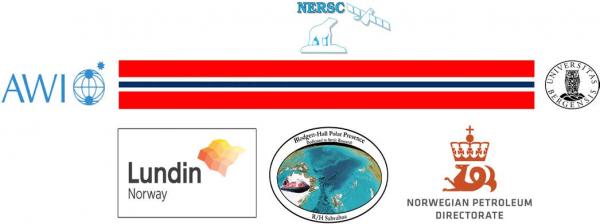
(25 May - 01 June 2015)
Ice drift
The ice camp has only made a southward progress of about 1 nautical mile (2 km) during week 39 (Fig. 1). The true drift was about 6 nautical miles to the southeast and then about 5 nautical miles back to the northwest again. The wind was from the north (10 knot) on Monday 25 May due to a weakening low pressure in the North Pole area. But for the rest of the week, winds (5-12 knot) were from the east and southeast. Our location was within outliers of the high pressure which moved between the Canadian Arctic and the coast of Siberia. The ice drift was to the southeast until Thursday morning when it turned towards the northwest.
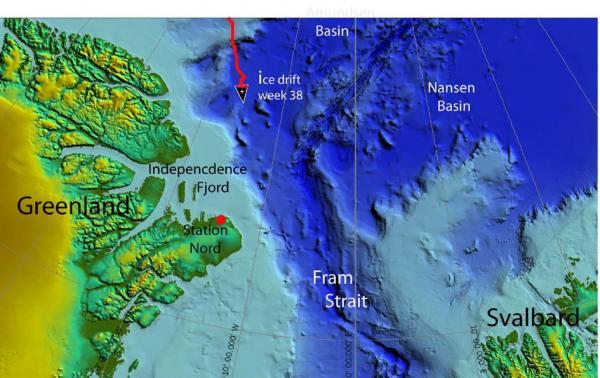
Fig. 1. The drift of FRAM-2014/15 during week 39, 25 - 01 June 2015 (short heavy red line).
Sea ice dynamics
No ice activity has been observed in our neighborhood during the week. The satellite image from 01 June in Fig. 2 shows the large scale fracture pattern northeast of Greenland. The northward ice drift has left a wide lead of open water running along the coast of Northeast Greenland.
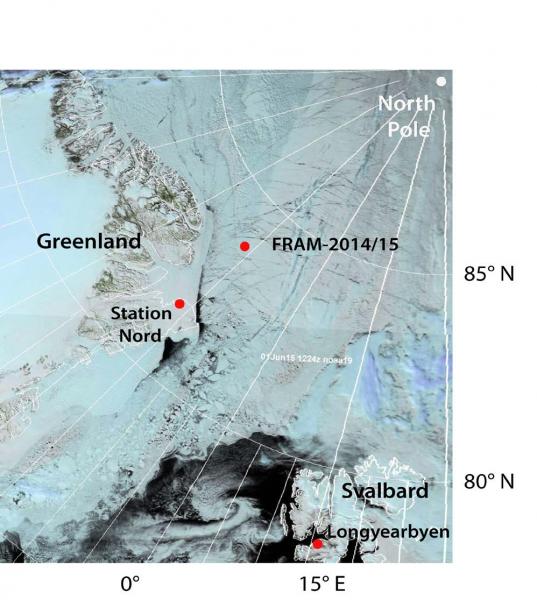
Fig. 2 Satellite image from 01 June courtesy of www.woksat.info showing ice distribution and fracture patterns north of Greenland and Svalbard.
Camp life
The net ice drift during week 39 was the lowest of all weeks during our nine months on the ice. We moved 6 nautical miles to the southeast and then 5 miles back in the direction we came from. Since we are on the home stretch and southward progress captures a lot of our attention, it has not been a good week. The first three days of the week had nice weather and we were occupied by our final recovery of the last thermistor in the string. Overcast and temperatures between -9 °C and - 3 °C dominated the rest of the week. A high point was the air drop offered by the Danish Arctic Command on Friday 29th (Fig. 3). The Challenger jet piloted by Kristian Kjær and his crew dropped a single parachute from 200 feet altitude (65 meter). Most importantly, the drop brought us resupply of antifreeze and spare radiator parts. We greatly appreciate the flexible attitude demonstrated by changing the flight schedule to compensate for the late arrival of cargo from Bergen to Kangerlussuaq. In our mind, the air drop is an excellent example of synergies in international cooperation. FRAM-2014/14 is drifting within a completely unexplored part of the Exclusive Economic Zone of Greenland/Denmark collecting geo-scientific data which in general terms are relevant to the resource potential of the region (see our report for week 35). "Rigsfelleskabet" retains at no costs, a copy of all the relevant information acquired during this part of the ice drift. A separate logistic operation to obtain the same information would require a double digit figure in millions of kroner.
The snow cover on the ice is visibly shrinking from the heat of the sun, and the surface is gradually getting glaced. Bluish areas are emerging where the snow cover is thin.
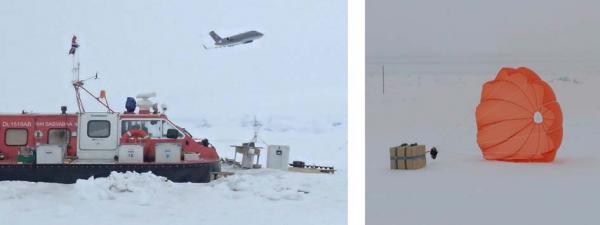
Fig. 3 Air drop from the Danish Air Force Challenger jet.
Science
Underway continuous measurements:
Bathymetry and sub-bottom profiling:
- none
Oceanography:
- 50 kHz and 200 kHz echo sounders to check for scattering layers in the upper 200 meter.
Atmosphere:
- measurement of incoming and outgoing radiation from the ice surface
- surface infrared skin temperature
- sun time
- Aanderaa weather station
Station work
- One CTD cast to 1000 meter depth
- One camera deployment to 22 meter and 55 meter depth
A CTD cast is done every 5 nautical mile, so only one was done during the week due to the slow drift.
The last of the autonomous buoys is not reporting useful bathymetry. It will be recovered when the weather conditions (light contrast) permit. Since our Knudsen echo sounder is dead, we are temporarily not collecting bathymetry.
Recovery of instruments suspended from wire connections frozen into the ice is a challenge which may be overcome by many different approaches. It is mostly an exercise in improvisation. The attached video clip shows an example of a classic device made to hook the kevlar line and pull the thermistor string out through the access hole. To recover the first thermistor just below the underside of the ice is a separate problem. In this case, the thermistor string was suspended from an 8 mm steel wire through the ice. The steel wire was at the center of three bundled plastic pipes (OD=90 mm) filled with ethanol. Based on previous experience, we considered it possible to lift the bundle out of the ice when the time of recovery came. However, the ice pressure had bent the pipe stack within the ice so lifting proved impossible. From a close access hole we managed to pull the steel wire downwards from the underside of the ice to give enough slack to allow the thermistor to become vertical within the access hole. The rest of the job was done by the hovercraft winch. All the gear was recovered without any damage.
Wild life
One and sometimes two snow buntings have been seen in camp every day during the week.
Life in the High Arctic is treating us well.
Yngve Kristoffersen & Audun Tholfsen
Daily reports
Monday 25 May
Position: 83° 42.7' N, 15° 48' W, temperature - 10° C, 1016 hPa, wind 10 knots from the NW. Ice drift 0.2 towards SE. Drove the hovercraft out to the site of the thermistor string mooring. Found the top of the mooring under an ice block at the edge of the pressure ridge. Drillen an access hole 40 cm away and hooked on to the string and pulled it up. Got everything up on the ice except thermistor # 1. Drove back to camp for the night.
Tuesday 26 May
Position: 83° 41.1' N, 15° 38' W, temperature - 10° C, 1025 hPa, wind 5 knot knots from the E. Ice drift 0.1 knot towards the SE. Went back towards the mooring site, but the hovercraft got stuck on an ice ridge underway. Had to jack the craft up to remove the ice ridge. Came loose, but got stuck two more times in ice rubble and had to use the winch to get out. . Drove back to camp in the evening
Wednesday 27 May
Position: 83° 39.7' N, 15° 32' W, temperature - 7° C, 1030 hPa, wind 4 knots from the SE. Ice drift 0.1 knot to the SE. Made a CTD cast down to 1000 meter. Returned to the thermistor site. Got the thermistor positioned vertically in the access hole so we could use the hovercraft winch to pull the Kevlar up and the mooring wire out of the ice. Everything came out with no damage. Drove back to camp. Had a shower in the sauna. The generator had to run all day to get enough water from melting snow.
Thursday 28 May
Position: 83° 39.7' N, 15° 32.5' W, temperature - 9° C, air pressure 1025 hPa, wind 6 knots from the SE. Ice drift 0.0. Checked the radiation flux instrument. Data logger had stopped and battery voltage 3.7 volt. Changed battery and restarted logger. Deployed the underwater camera into the scattering layer - first at 22 meter depth and then at 55 meter depth. Abundant activity, but no good images captured beyond what we already have.
Friday 29 May
Position: 83° 39.4' N, 15° 31' W, temperature - 9° C, pressure 1028 hPa, wind 5 knots from the SE. Overcast and low light contrast of the ice surface. The Danish Air Force 5954 Challenger coastal surveillance plane came overheat at 1545 GMT and dropped a parachute from 60 meter height. We received resupply of antifreeze and spares for hovercraft radiator, spare swords for the chain saw and battery for one of the laptops. A thank you note was dispatched to the Danish Arctic Command expressing our appreciation for the service rendered.
Saturday 30 May
Position: 83° 41.6' N, 15° 48' W, temperature - 5° C, air pressure 1019 hPa, wind 12 knots from the SE. Ice drift 0.2 knot towards the NW. Checked the radiation flux instrument. Data logger voltage 12.6 volt. Checked weather station - battery is 10.3 volt.
Sunday 31 May
Position: 83° 43.2' N, 16° 08' W, , temperature - 5° C, air pressure 1023 hPa, wind 6 knots from the SE. Ice drift 0.1 knot to the W. The northwestward drift is very disappointing and the weather forecast suggests this will go on until Tuesday next week.
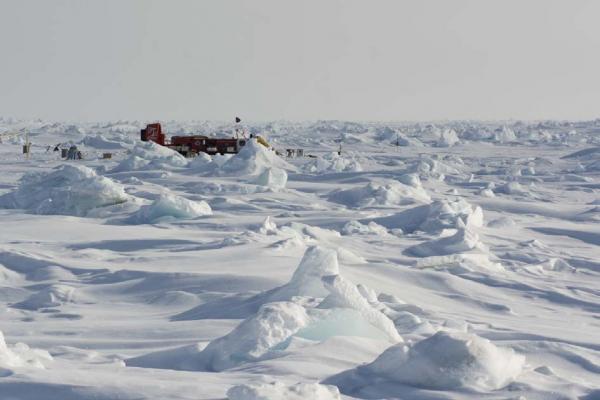
The FRAM-2014/15 camp on May 29 2015.
